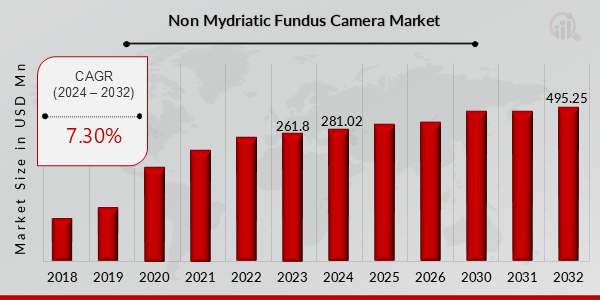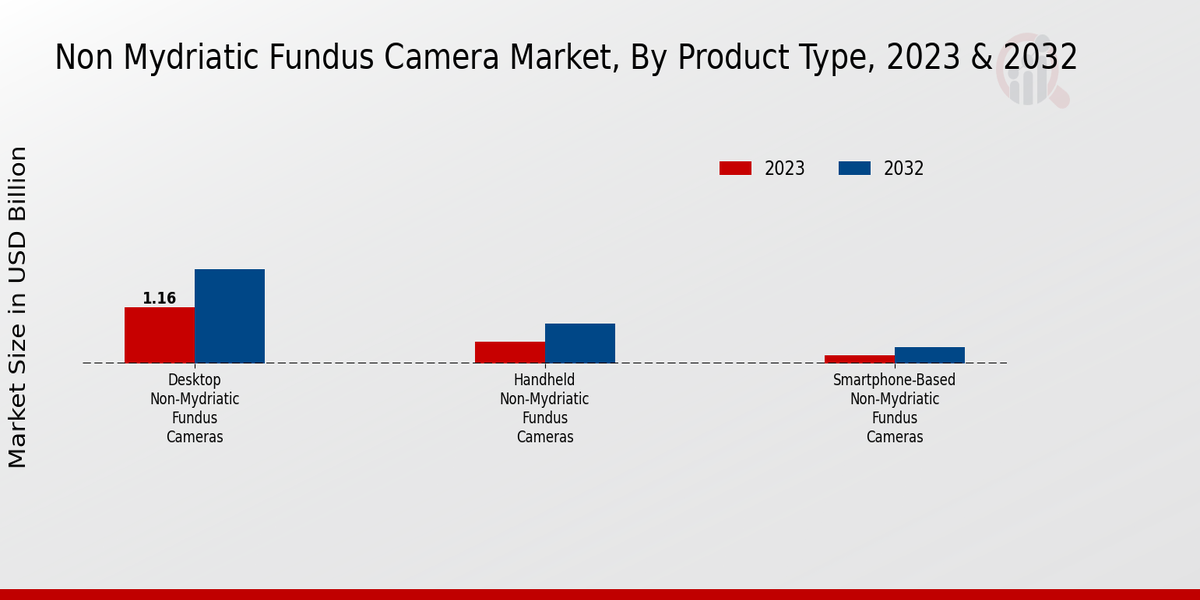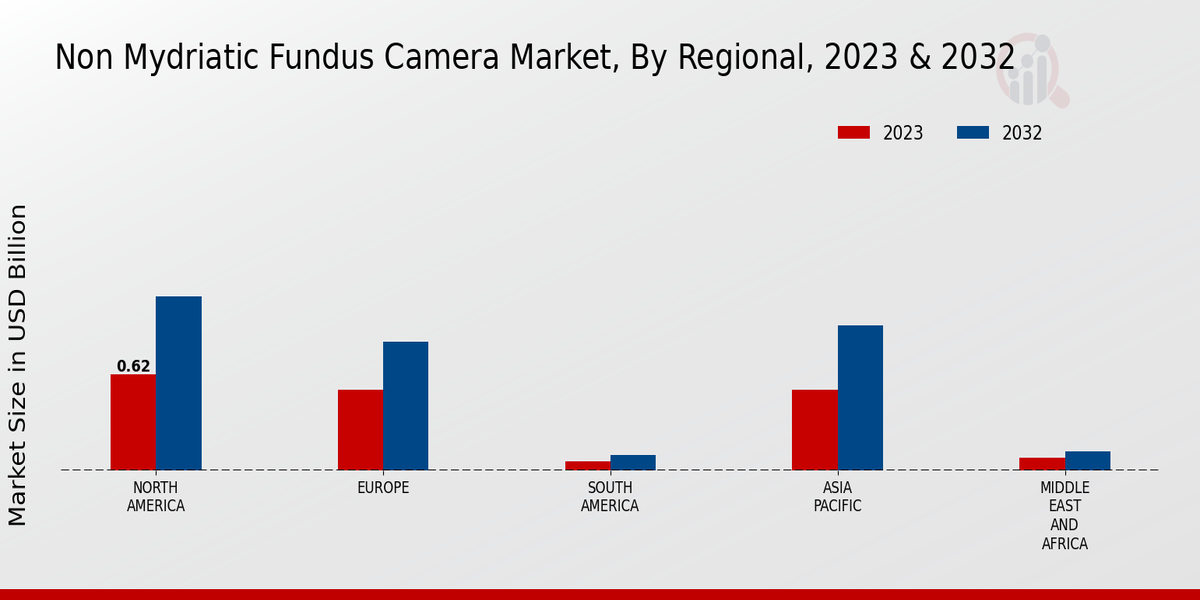Global Non Mydriatic Fundus Camera Market Overview:
Non Mydriatic Fundus Camera Market Size was estimated at 261.8 (USD Million) in 2023. The Non Mydriatic Fundus Camera Market Industry is expected to grow from 281.02 (USD Million) in 2023 to 495.25 (USD Million) by 2032. The Non Mydriatic Fundus Camera Market CAGR (growth rate) is expected to be around 7.30% during the forecast period (2024 - 2032)
Key Non Mydriatic Fundus Camera Market Trends Highlighted
The Non Mydriatic Fundus Camera Market is getting uplifted with the advancement of technology, a higher rate of increase in the incidence of eye disorders, and a lack of knowledge with regard to the care of the eye. The growth in the aged population and the burden of diabetes and other chronic diseases is positive for the market as well. In addition, the increased uptake of wide-angle imaging with optical coherence tomography (OCT) and artificial intelligence analysis improves the quality and practice of fundus imaging, which in turn expands the market. The market is also supported by the improvement of health care systems and government policies that support the availability of eye care services in less developed countries.

Source: Primary Research, Secondary Research, MRFR Database and Analyst Review
Non Mydriatic Fundus Camera Market Drivers
Increasing Prevalence of Eye Disorders
An essential factor driving the Non Mydriatic Fundus Camera Market Industry is the increasing prevalence of eye disorders such as age-related macular degeneration, diabetic retinopathy, and glaucoma. According to the World Health Organization, these disorders affect a considerable proportion of the population, with an even higher prevalence among the elderly. Non-mydriatic fundus cameras use advanced technology to provide clear, high-quality images of the retina, allowing ophthalmologists to diagnose and monitor these conditions effectively.With the continued aging of the global population and the increasing prevalence of such eye disorders, the demand for nonmydriatic fundus cameras in the global market is expected to grow significantly.
Technological Advancements
Technological advancements in non-mydriatic fundus cameras are another key driver of market growth. The introduction of features such as high-resolution imaging, wide-field imaging, and optical coherence tomography (OCT) has significantly improved the diagnostic capabilities of these devices. These advanced features allow ophthalmologists to visualize the retina in greater detail, detect subtle changes, and diagnose eye disorders more accurately. The ongoing development of artificial intelligence (AI) and machine learning algorithms is further enhancing the capabilities of non-mydriatic fundus cameras, enabling automated analysis of retinal images and improved diagnostic accuracy.These technological advancements are expected to continue in the coming years, driving the adoption of non-mydriatic fundus cameras in the Non Mydriatic Fundus Camera Market Industry.
Growing Demand for Telemedicine
An additional factor contributing to the development of the Non Mydriatic Fundus Camera Market Industry is the growing demand for telemedicine. According to Sahoo, telemedicine “uses technology to deliver health care, health information, or health education at a distance”. This technology could be useful when eye health is at stake. Non-mydriatic fundus cameras allow ophthalmologists to take photographs of the retina without dilation. This procedure could be done remotely as specialists can access a patient’s retina image from a distance.Patients from rural or remote areas who do not have specialized eye care available could thus be diagnosed. The current conditions of the COVID-19 pandemic and the growing demand for fast and easily accessible general healthcare are stimulating the increase in telemedicine facilities. Hence, the growing use of telemedicine will contribute to the strong demand for non-mydriatic fundus cameras in the Non Mydriatic Fundus Camera Market Industry.
Non Mydriatic Fundus Camera Market Segment Insights:
Non Mydriatic Fundus Camera Market Product Type Insights
The Global Non-Mydriatic Fundus Camera Market is segmented by product type as desktop, handheld, and smartphone-based non-mydriatic fundus camera. The desktop non-mydriatic fundus camera segment is expected to hold a large market share in 2023 because they produces high-quality and advanced imaging and has provision for retinal screening. It is largely being adopted by small clinics and large centers. Additionally, the convenience of image capturing facilitates its adoption. However, the handheld non-mydriatic fundus camera segment is expected to witness the highest CAGR over the forecast period because it is lightweight, small in size and portable, offers both mydriatic and non mydriatic imaging and provides bright LED and easy control to capture direct images of the eyes without movement.Additionally, the smartphone-based non-mydriatic fundus camera segment is also expected to witness significant growth over the forecast period because these devices are user friendly, affordable and easy to handle in different settings. The major factors attributing the growth of this market include increasing population of eye diseases, use of non-mydriatic cameras images in clinical settings and increasing demand for portable and cost-effective fundus camera.

Source: Primary Research, Secondary Research, MRFR Database and Analyst Review
Non Mydriatic Fundus Camera Market Application Insights
The Non Mydriatic Fundus Camera Market is segmented by Application into Routine Eye Exam, Diabetic Retinopathy Screening, Glaucoma Screening, Age-Related Macular Degeneration Monitoring, and Others. Among these segments, Diabetic Retinopathy Screening is expected to hold the largest market share of around 35.4% in 2023 and is projected to reach 40.9% by 2032, owing to the increasing prevalence of diabetes and the need for regular eye exams to detect and manage diabetic retinopathy. Routine Eye Exam is another major segment, which is expected to account for around 29.1% of the Non Mydriatic Fundus Camera Market revenue in 2023 and is projected to reach 32.5% by 2032, due to the rising awareness about the importance of regular eye exams for early detection and prevention of eye diseases.Glaucoma Screening and Age-Related Macular Degeneration Monitoring are also significant segments, with Glaucoma Screening expected to grow at a CAGR of 6.9% and Age-Related Macular Degeneration Monitoring expected to grow at a CAGR of 6.5% during the forecast period.
Non Mydriatic Fundus Camera Market End User Insights
Ophthalmology clinics account for the largest share of the Non Mydriatic Fundus Camera Market revenue due to the high prevalence of eye diseases and the need for specialized equipment for diagnosis and treatment. Hospitals are also major end user, as they offer a wide range of eye care services, including non-mydriatic fundus imaging. Optical stores are another important end user, as they offer non-mydriatic fundus imaging as a value-added service to their customers. Research institutions are also growing end user, as they use non-mydriatic fundus imaging for research purposes.The Non Mydriatic Fundus Camera Market is expected to grow at a CAGR of 6.31% from 2024 to 2032, driven by the increasing prevalence of eye diseases, the rising demand for non-invasive imaging techniques, and the technological advancements in non-mydriatic fundus cameras.
Non Mydriatic Fundus Camera Market Regional Insights
The North American region held the largest market share in the Non Mydriatic Fundus Camera Market in 2023 and is projected to continue its dominance throughout the forecast period. The prevalence of diabetic retinopathy and age-related macular degeneration in the region's aging population, coupled with the increasing adoption of advanced technologies, contributes to the regional market growth. Europe stands as the second-largest market, driven by the presence of well-established healthcare systems and increasing awareness about eye health.The APAC region is expected to exhibit the highest growth rate during the forecast period owing to the rising prevalence of eye diseases, expanding healthcare infrastructure, and government initiatives promoting eye care. South America and MEA hold smaller market shares but are projected to witness steady growth due to improved healthcare access and economic development.


Source: Primary Research, Secondary Research, MRFR Database and Analyst Review
Non Mydriatic Fundus Camera Market Key Players And Competitive Insights:
The non mydriatic fundus camera market industry is highly complex and dynamic in nature. Major players are constantly making efforts to gain a competitive edge by investing in R, expanding their product portfolios, and forming strategic alliances. The leading players operating in the industry are focusing on developing innovative technologies to provide better image quality, faster acquisition times, and patient comfort. Fundus autofluorescence imaging, widefield imaging, and optical coherence tomography are among the prime areas of development. These developments are anticipated to boost the growth of the Non Mydriatic Fundus Camera Market market in the upcoming years.
The competitive surrounding of the industry is characterized by the presence of both key players and new entries. The existing players are well-established in the market and have a significant customer base. The new entries are striving to create a foothold in the market by introducing newer technologies and solutions. Leading players are adopting strategic approaches such as acquisitions, partnerships, joint ventures, and others to expand their market share and increase competitiveness.
Topcon Healthcare is one of the major providers of ophthalmic imaging and diagnostic equipment. The company offers a high-resolution fundus camera, the Maestro2, which is specifically designed to provide clear and detailed images of the retina. It eliminates the need for pupil dilation and has a number of features that make it suitable for a wide range of clinical settings. These features include widefield imaging, autofluorescence imaging, and optical coherence tomography. The company also offers a range of ophthalmic imaging products, including slit lamps, tonometers, and biometers.
Key Companies in the Non Mydriatic Fundus Camera Market Include:
-
Optovue, Inc
-
Optos plc
-
Carl Zeiss Meditec
-
Q Ophthalmics
-
Huvitz Co., Ltd.
-
Nidek Technologies
-
HaagStreit
-
ophthalmic Imaging
-
Canon
-
Topcon
-
Volk Optical, Inc.
-
Kowa Company
-
Ziess AG
-
BIO
Non Mydriatic Fundus Camera Industry Developments
The global non-mydriatic fundus camera market is experiencing significant growth due to the increasing prevalence of diabetic retinopathy, glaucoma, and other eye diseases. Technological advancements such as artificial intelligence (AI)-powered retinal imaging and ultra-widefield imaging capabilities are driving market expansion. Key players like Canon, Topcon, and Zeiss are investing in RD to enhance product offerings and cater to the growing demand for non-invasive and portable fundus cameras. Strategic collaborations and partnerships are also shaping the market landscape, with companies seeking to expand their geographical reach and strengthen their competitive positioning.
Non Mydriatic Fundus Camera Market Segmentation Insights
Non Mydriatic Fundus Camera Market Product Type Outlook
- Desktop Non-Mydriatic Fundus Cameras
- Handheld Non-Mydriatic Fundus Cameras
- Smartphone-Based Non-Mydriatic Fundus Cameras
Non Mydriatic Fundus Camera Market Application Outlook
- Routine Eye Exam
- Diabetic Retinopathy Screening
- Glaucoma Screening
- Age-Related Macular Degeneration Monitoring
Non Mydriatic Fundus Camera Market End User Outlook
- Ophthalmology Clinics
- Hospitals
- Optical Stores
- Research Institutions
Non Mydriatic Fundus Camera Market Regional Outlook
- North America
- Europe
- South America
- Asia Pacific
- Middle East and Africa
| Report Attribute/Metric |
Details |
| Market Size 2023 |
261.8 (USD Million) |
| Market Size 2024 |
281.02 (USD Million) |
| Market Size 2032 |
495.25 (USD Million) |
| Compound Annual Growth Rate (CAGR) |
7.30% (2024 - 2032) |
| Report Coverage |
Revenue Forecast, Competitive Landscape, Growth Factors, and Trends |
| Base Year |
2023 |
| Market Forecast Period |
2024 - 2032 |
| Historical Data |
2019 - 2023 |
| Market Forecast Units |
USD Million |
| Key Companies Profiled |
Optovue, Inc, Optos plc, Carl Zeiss Meditec, Q Ophthalmics, Huvitz Co., Ltd., Nidek Technologies, HaagStreit, ophthalmic Imaging, Canon, Topcon, Volk Optical, Inc., Kowa Company, Ziess AG, BIO |
| Segments Covered |
Product Type, Application, End User, Regional |
| Key Market Opportunities |
Early disease detection telemedicine applications mobile health integration artificial intelligence-powered analysis wearable fundus cameras |
| Key Market Dynamics |
Rising demand for early disease detection Technological advancements Increasing prevalence of eye diseases Growing healthcare spending Expanding reimbursement policies |
| Countries Covered |
North America, Europe, APAC, South America, MEA |
Frequently Asked Questions (FAQ) :
The Non Mydriatic Fundus Camera Market is estimated to be worth 261.8 Million USD in 2023.
The Non Mydriatic Fundus Camera Market is projected to grow at a CAGR of 7.30% from 2024 to 2032.
North America is expected to hold the largest market share in the Non Mydriatic Fundus Camera Market in 2032.
Key applications of Non Mydriatic Fundus Cameras include diabetic retinopathy screening, glaucoma diagnosis, and macular degeneration monitoring.
Key competitors in the Non Mydriatic Fundus Camera Market include Topcon, Canon, Zeiss, and Nidek.
Factors driving the growth of the Non Mydriatic Fundus Camera Market include the increasing prevalence of eye diseases, the growing adoption of telemedicine, and the rising demand for non-invasive diagnostic procedures.
Challenges faced by the Non Mydriatic Fundus Camera Market include the high cost of devices, the need for trained professionals to operate them, and the potential for inaccurate readings.
Emerging trends in the Non Mydriatic Fundus Camera Market include the development of AI-powered devices, the integration of cloud-based platforms, and the growing use of mobile fundus cameras.
The Non Mydriatic Fundus Camera Market is projected to reach 3.1 billion USD by 2032.
Opportunities for growth in the Non Mydriatic Fundus Camera Market include the expansion of telemedicine services, the development of new applications for fundus cameras, and the increasing awareness of eye diseases.

















